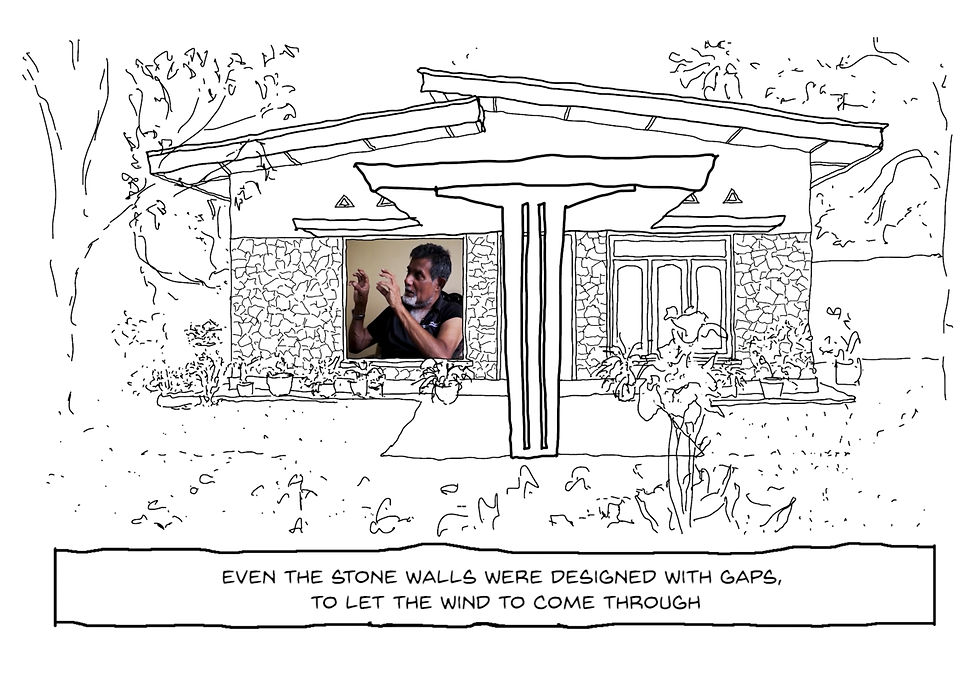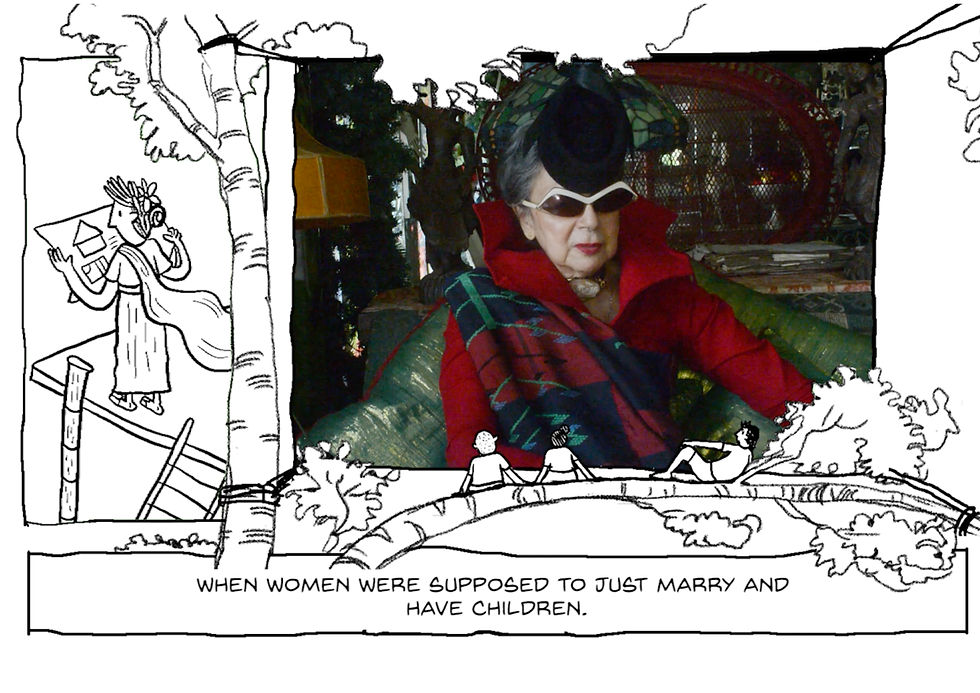The Ghost of Watapuluwa
- The Aleph Review
- May 14, 2024
- 3 min read
Updated: May 15, 2024
Kulsum Ebrahim
A review of Is this an Architectural Documentary? (2023) — a film by Irushi Tennekoon, Sumedha Kelegama, Sumudu Athukorala; an animated documentary about the first Sri Lankan woman architect. Language: English and Sinhala

Imagine a ghost. Her sari billows behind her as she expertly hikes up a rickety ladder, hair pulled into a tight bun, a velvety rose tucked behind her ear. Intelligent eyes blink behind rock-star aviators. You can just tell she has a wicked sense of humour.
I encountered Minnette De Silva earlier this year in an animated documentary film by three Sri Lankan artists titled Is this an Architectural Documentary?, currently screening at the Museum of Modern and Contemporary Art Sri Lanka. I watched it from my bedroom in Karachi, Pakistan, missing the film in its intended, complete context of the 88 Acres exhibition on De Silva’s Watapuluwa Housing Scheme at the MMCA Sri Lanka, which is up till 7 July 2024. The film positions De Silva as an architect and researcher interested in vernacular architecture. She is the first Sri Lankan woman architect and the first Asian woman to be an associate of the Royal Institute of British Architects (RIBA). Despite these accolades, this is my first encounter with Minnette.
It is a glaringly political film, claiming to uncover the history of a forgotten housing scheme in Kandy. This first-of-its-kind Watapuluwa Housing Scheme was designed by Minnette De Silva in post-Independence Sri Lanka for public servants. Through their presentation of the Watapuluwa Housing Scheme, the artists make a strong case for participatory architecture. In this instance, the scheme came about through advocacy of the Housewives Association founded by the wives of the public servants and was designed after conducting extensive user surveys. The documentary will be most enjoyed by urbanists, architects, planners, historians, and is an incredible resource for students and teachers, filled with ideas and experiments on collective living. Whilst rigorous in their research, evident in the number of interviews and volume of archival documents, the artists are upfront from the start and never claim to tell One True Story, admitting that their ghost story, like all others, is made up of myths and rumours. Their diverse practices deliver an interdisciplinary look into the life and work of an extraordinary woman.
Even whilst watching from my bedroom, I am enchanted from the start. By both Minnette and the invitation of the film: to imagine new worlds and to be fearless in bringing these visions to life. I can’t help but think wistfully about my brief London era as I learn about Minnette’s London period, which the film marks as significant to her work, politics, and thinking. When a participant describes a loom outside Minnette’s home in Kandy, I immediately wish for a home on a hill with a clove-scented verandah where I sit at my loom all day—new desire unlocked.
The reflexive documentary tells a full story of Minnette De Silva: as architect, friend, colleague, mentor, aunt, woman. The sheer number of people interviewed, the breadth of their expertise, and their impassioned responses quickly reveal her influence, her vastness, and how, in a ghost-like way, she continues to touch the lives of so many. By delving deep into her personhood, the artists point out how architecture is personal, subjective, political, driven by values, beliefs, aesthetic preferences, identities, upbringing, and experiences of the architect. At the same time, the artists inform the audience about the larger context: the historical, political, social, cultural, and economic conditions Minnette worked in in Post-Independence Sri Lanka.




Live-action footage, archival images and documents, stop-motion puppets, 3D renders, and architectural plans are elegantly placed within sketchy hand-drawn frames that show-off impressive perspective drawing skills and clever wit. This marriage of diverse visual materials serves the reflexive mode. The artists are depicted as illustrated characters accompanying the audience for the duration of the film. By placing the makers within their creation in this way, the audience is made aware of the ‘constructedness’ of the film. Tennekoon’s smooth voiceover with its Lankan lilt anchors us through the saga of the trailblazing Modernist architect. In many ways, the film itself stands as a testament to Minnette’s methodologies. It is participatory, specifically including the voices of the residents of the scheme. Like Minnette, the artists experiment with materials to develop a whole new vernacular of documentary film to suit the story. Therefore, to answer the question posed by the artists: ‘Is this an architectural documentary?’
I would say very much, yes!
Photo Credits:
Minnette De Silva portrait — Creative Commons
Stills from the documentary are courtesy of the filmmakers.

Kulsum Ebrahim is a visual artist working in animation and film based between Karachi and London. She is interested in cities, health, mobility, and ecology and believes in the revolutionary potential of animation. She graduated with an MA in Animation from the Royal College of Art in 2023.

Comments